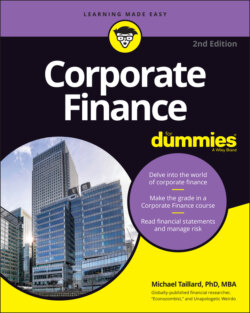Читать книгу Corporate Finance For Dummies - Michael Taillard - Страница 33
Funds
ОглавлениеDuring the early days of the Christian church and then again in the United States in the 1960s, groups often pooled all their assets together and allowed them to be managed for the good of the group. Funds are basically the free-market-investor version of this collective idea. Individuals pool their money together in a fund, that money is managed as a single investment portfolio, and the individuals who contributed to that portfolio (the fund) receive returns on their investments proportional to their ownership in the returns generated by the entire portfolio.
The point of pooling assets is to make professional investments and investing strategies available to people who otherwise wouldn’t have the resources on their own to pursue such investments. Funds are popular options for corporations to provide for the retirement funds of their employees, but corporations themselves also frequently trust their investment management to a fund. Generally speaking, each fund has its own investing strategy, so investors choosing between funds must pick one that has a strategy they believe will most benefit them.
Funds come in two types — hedge funds and mutual funds — and although they both have the same fundamental principles, each type has some unique traits, processes, regulations, and variations. Table 2-1 gives you a quick look at the main differences.
TABLE 2-1 Differences between Hedge Funds and Mutual Funds
| Hedge Funds | Mutual Funds | |
|---|---|---|
| Strategy | Managers have more freedom in their use of investment tools and an ability to change strategy as they see fit. | Managers must adhere strictly to the strategy described when the fund was established and must choose from a rather limited range of investment types. |
| Fees | Hedge funds typically charge a fee based on the performance of the fund; the better the fund performs in the market, the more the investors pay in fees. | Mutual funds are highly regulated in terms of the amount they can charge in fees and the types of fees they can charge. (For instance, 12b-1 fees are those related to the administrative functions of the fund and are capped by the Securities and Exchange Commission.) |
| Shares | Hedge funds pool the assets of the investors collectively and invest them. | Mutual funds sell shares of a pool, which is either indefinite, meaning that there are no restrictions on the number of shares issued and that the fund buys back shares as they are sold by investors, or traded like stocks, depending on whether the mutual fund is open-end or closed-end, respectively. |
